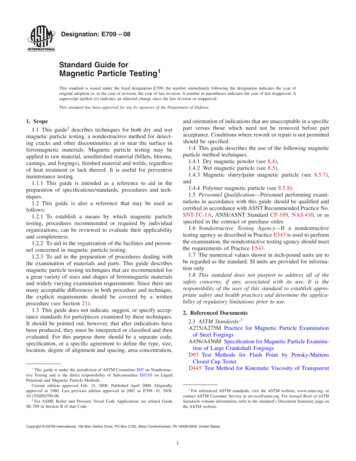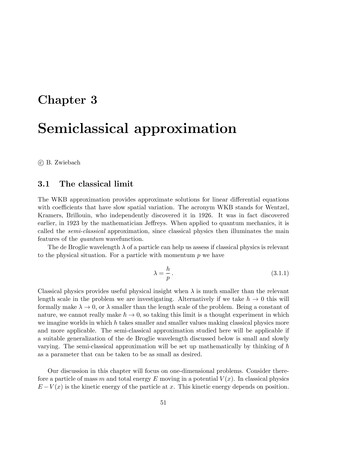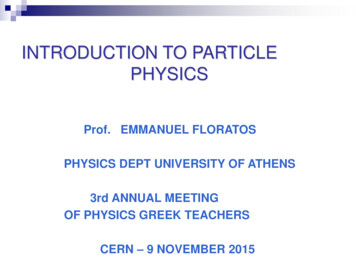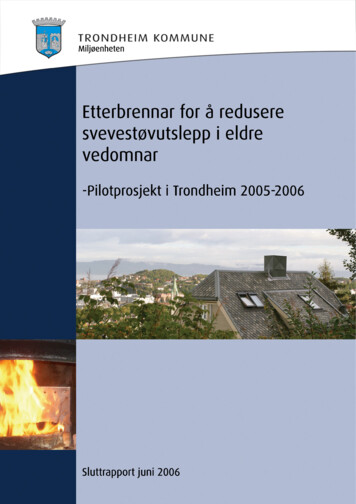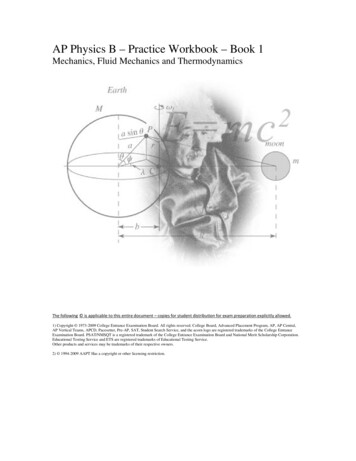
Transcription
PARTICLE PHYSICSEdited by Eugene Kennedy
Particle PhysicsEdited by Eugene KennedyPublished by InTechJaneza Trdine 9, 51000 Rijeka, CroatiaCopyright 2012 InTechAll chapters are Open Access distributed under the Creative Commons Attribution 3.0license, which allows users to download, copy and build upon published articles even forcommercial purposes, as long as the author and publisher are properly credited, whichensures maximum dissemination and a wider impact of our publications. After this workhas been published by InTech, authors have the right to republish it, in whole or part, inany publication of which they are the author, and to make other personal use of thework. Any republication, referencing or personal use of the work must explicitly identifythe original source.As for readers, this license allows users to download, copy and build upon publishedchapters even for commercial purposes, as long as the author and publisher are properlycredited, which ensures maximum dissemination and a wider impact of our publications.NoticeStatements and opinions expressed in the chapters are these of the individual contributorsand not necessarily those of the editors or publisher. No responsibility is accepted for theaccuracy of information contained in the published chapters. The publisher assumes noresponsibility for any damage or injury to persons or property arising out of the use of anymaterials, instructions, methods or ideas contained in the book.Publishing Process Manager Vana PersenTechnical Editor Teodora SmiljanicCover Designer InTech Design TeamFirst published April, 2012Printed in CroatiaA free online edition of this book is available at www.intechopen.comAdditional hard copies can be obtained from orders@intechopen.comParticle Physics, Edited by Eugene Kennedyp. cm.ISBN 978-953-51-0481-0
ContentsPreface VIIChapter 1The Generation Model of Particle Physics 1Brian RobsonChapter 2Constraining the Couplingsof a Charged Higgs to Heavy QuarksA. S. Cornell29Chapter 3Introduction to Axion Photon Interactionin Particle Physics and PhotonDispersion in Magnetized Media 49Avijit K. GangulyChapter 4The e-Science Paradigm for Particle PhysicsKihyeon ChoChapter 5Muon Colliders and Neutrino Effective DosesJoseph John Bevelacqua7591
PrefaceInterest in particle physics continues apace. With the Large Hadron Collider showingearly tantalizing glimpses of what may yet prove to be the elusive Higgs Boson,particle physics remains a fertile ground for creative theorists. While the Standardmodel of particle physics remains hugely successful, nevertheless it is still not fullyregarded as a complete holistic description. This book describes the development ofwhat is termed the generation model, which is proposed as an alternative to thestandard model and provides a new classification approach to fundamental particles.A further chapter describes an extension to the standard model involving thepossibility of a charged Higgs boson and includes an outline of how experimentalevidence may be sought at LHC and B‐factory facilities. Coupling of postulated axionparticles to photons is tackled with particular reference to magnetized media, togetherwith possible implications for detection in laboratory experiments or astrophysicalobservations. Modern particle physics now involves major investments in hardwarecoupled with large‐scale theoretical and computational efforts. The complexity of suchsynergistic coordinated entities is illustrated within the framework of the e‐scienceparadigm. Finally, an unexpected and interesting description of the potential radiationhazards associated with extremely weakly interacting neutrinos is provided in thecontext of possible future designs of intense muon‐collider facilities.Eugene KennedyEmeritus ProfessorSchool of Physical Sciences,Dublin City UniversityIreland
1The Generation Model of Particle PhysicsBrian RobsonDepartment of Theoretical Physics, Research School of Physics and Engineering,The Australian National University, CanberraAustralia1. IntroductionThe main purpose of this chapter is to present an alternative to the Standard Model (SM)(Gottfried and Weisskopf, 1984) of particle physics. This alternative model, called theGeneration Model (GM) (Robson, 2002; 2004; Evans and Robson, 2006), describes all thetransition probabilities for interactions involving the six leptons and the six quarks, whichform the elementary particles of the SM in terms of only three unified additive quantumnumbers instead of the nine non-unified additive quantum numbers allotted to the leptonsand quarks in the SM.The chapter presents (Section 2) an outline of the current formulation of the SM: theelementary particles and the fundamental interactions of the SM, and the basic probleminherent in the SM. This is followed by (Section 3) a summary of the GM, highlighting theessential differences between the GM and the SM. Section 3 also introduces a more recentdevelopment of a composite GM in which both leptons and quarks have a substructure.This enhanced GM has been named the Composite Generation Model (CGM) (Robson, 2005;2011a). In this chapter, for convenience, we shall refer to this enhanced GM as the CGM,whenever the substructure of leptons and quarks is important for the discussion. Section 4focuses on several important consequences of the different paradigms provided by the GM.In particular: the origin of mass, the mass hierarchy of the leptons and quarks, the origin ofgravity and the origin of apparent CP violation, are discussed. Finally, Section 5 provides asummary and discusses future prospects.2. Standard model of particle physicsThe Standard Model (SM) of particle physics (Gottfried and Weisskopf, 1984) was developedthroughout the 20th century, although the current formulation was essentially finalized in themid-1970s following the experimental confirmation of the existence of quarks (Bloom et al.,1969; Breidenbach et al., 1969).The SM has enjoyed considerable success in describing the interactions of leptons and themultitude of hadrons (baryons and mesons) with each other as well as the decay modes of theunstable leptons and hadrons. However the model is considered to be incomplete in the sensethat it provides no understanding of several empirical observations such as: the existenceof three families or generations of leptons and quarks, which apart from mass have similarproperties; the mass hierarchy of the elementary particles, which form the basis of the SM; thenature of the gravitational interaction and the origin of CP violation.
22ParticlePhysicsWill-be-set-by-IN-TECHIn this section a summary of the current formulation of the SM is presented: the elementaryparticles and the fundamental interactions of the SM, and then the basic problem inherent inthe SM.2.1 Elementary particles of the SMIn the SM the elementary particles that are the constituents of matter are assumed to be thesix leptons: electron neutrino (νe ), electron (e ), muon neutrino (νμ ), muon (μ ), tau neutrino(ντ ), tau (τ ) and the six quarks: up (u), down (d), charmed (c), strange (s), top (t) and bottom(b), together with their antiparticles. These twelve particles are all spin- 12 particles and fallnaturally into three families or generations: (i) νe , e , u, d ; (ii) νμ , μ , c, s ; (iii) ντ , τ , t, b .Each generation consists of two leptons with charges Q 0 and Q 1 and two quarks withcharges Q 23 and Q 13 . The masses of the particles increase significantly with eachgeneration with the possible exception of the neutrinos, whose very small masses have yet tobe determined.In the SM the leptons and quarks are allotted several additive quantum numbers: chargeQ, lepton number L, muon lepton number Lμ , tau lepton number Lτ , baryon number A,strangeness S, charm C, bottomness B and topness T. These are given in Table 1. Foreach particle additive quantum number N, the corresponding antiparticle has the additivequantum number N.particleνee νμμ νττ udcstbQ0 10 10 1 23 13 23 13 23 00131313131313S C0 00 00 00 00 00 00 00 00 1 1 00 00 0B00000000000 1T000000000010Table 1. SM additive quantum numbers for leptons and quarksTable 1 demonstrates that, except for charge, leptons and quarks are allotted different kindsof additive quantum numbers so that this classification of the elementary particles in the SMis non-unified.The additive quantum numbers Q and A are assumed to be conserved in strong,electromagnetic and weak interactions. The lepton numbers L, Lμ and Lτ are not involved instrong interactions but are strictly conserved in both electromagnetic and weak interactions.The remainder, S, C, B and T are strictly conserved only in strong and electromagneticinteractions but can undergo a change of one unit in weak interactions.The quarks have an additional additive quantum number called “color charge", which cantake three values so that in effect we have three kinds of each quark, u, d, etc. These are often
TheGenerationModelof Particle PhysicsThe GenerationModel of ParticlePhysics33called red, green and blue quarks. The antiquarks carry anticolors, which for simplicity arecalled antired, antigreen and antiblue. Each quark or antiquark carries a single unit of color oranticolor charge, respectively. The leptons do not carry a color charge and consequently do notparticipate in the strong interactions, which occur between particles carrying color charges.2.2 Fundamental interactions of the SMThe SM recognizes four fundamental interactions in nature: strong, electromagnetic, weakand gravity. Since gravity plays no role in particle physics because it is so much weaker thanthe other three fundamental interactions, the SM does not attempt to explain gravity. In theSM the other three fundamental interactions are assumed to be associated with a local gaugefield.2.2.1 Strong interactionsThe strong interactions, mediated by massless neutral spin-1 gluons between quarks carryinga color charge, are described by an SU (3) local gauge theory called quantum chromodynamics(QCD) (Halzen and Martin, 1984). There are eight independent kinds of gluons, each of whichcarries a combination of a color charge and an anticolor charge (e.g. red-antigreen). The stronginteractions between color charges are such that in nature the quarks (antiquarks) are groupedinto composites of either three quarks (antiquarks), called baryons (antibaryons), each havinga different color (anticolor) charge or a quark-antiquark pair, called mesons, of opposite colorcharges. In the SU (3) color gauge theory each baryon, antibaryon or meson is colorless.However, these colorless particles, called hadrons, may interact strongly via residual stronginteractions arising from their composition of colored quarks and/or antiquarks. On the otherhand the colorless leptons are assumed to be structureless in the SM and consequently do notparticipate in strong interactions.2.2.2 Electromagnetic interactionsThe electromagnetic interactions, mediated by massless neutral spin-1 photons betweenelectrically charged particles, are described by a U (1) local gauge theory called quantumelectrodynamics (Halzen and Martin, 1984).2.2.3 Weak interactionsThe weak interactions, mediated by the massive W , W and Z0 vector bosons betweenall the elementary particles of the SM, fall into two classes: (i) charge-changing (CC) weakinteractions involving the W and W bosons and (ii) neutral weak interactions involvingthe Z0 boson. The CC weak interactions, acting exclusively on left-handed particles andright-handed antiparticles, are described by an SU (2) L local gauge theory, where the subscriptL refers to left-handed particles only (Halzen and Martin, 1984). On the other hand, theneutral weak interactions act on both left-handed and right-handed particles, similar to theelectromagnetic interactions. In fact the SM assumes (Glashow, 1961) that both the Z0 and thephoton (γ) arise from a mixing of two bosons, W 0 and B0 , via an electroweak mixing angleθW :γ B0 cos θW W 0 sin θW ,(1)Z B0 sin θW W 0 cos θW .(2)0
44ParticlePhysicsWill-be-set-by-IN-TECHThese are described by a U (1) SU (2) L local gauge theory, where the U (1) symmetryinvolves both left-handed and right-handed particles.Experiment requires the masses of the weak gauge bosons, W and Z, to be heavy so thatthe weak interactions are very short-ranged. On the other hand, Glashow’s proposal, basedupon the concept of a non-Abelian SU (2) Yang-Mills gauge theory, requires the mediators ofthe weak interactions to be massless like the photon. This boson mass problem was resolvedby Weinberg (1967) and Salam (1968), who independently employed the idea of spontaneoussymmetry breaking involving the Higgs mechanism (Englert and Brout, 1964; Higgs, 1964).In this way the W and Z bosons acquire mass and the photon remains massless.The above treatment of the electromagnetic and weak interactions in terms of a U (1) SU (2) Llocal gauge theory has become known as the Glashow, Weinberg and Salam (GWS) model andforms one of the cornerstones of the SM. The model gives the relative masses of the W and Zbosons in terms of the electroweak mixing angle:MW MZ cos θW .(3)The Higgs mechanism was also able to cure the associated fermion mass problem (Aitchisonand Hey, 1982): the finite masses of the leptons and quarks cause the Lagrangian describingthe system to violate the SU (2) L gauge invariance. By coupling originally massless fermionsto a scalar Higgs field, it is possible to produce the observed physical fermion masses withoutviolating the gauge invariance. However, the GWS model requires the existence of a newmassive spin zero boson, the Higgs boson, which to date remains to be detected. In addition,the fermion-Higgs coupling strength is dependent upon the mass of the fermion so that a newparameter is required for each fermion mass in the theory.In 1971, t’Hooft (1971a,b) showed that the GWS model of the electroweak interactions wasrenormalizable and this self-consistency of the theory led to its general acceptance. In 1973,events corresponding to the predicted neutral currents mediated by the Z0 boson wereobserved (Hasert et al., 1973; 1974), while bosons, with approximately the expected masses,were discovered in 1983 (Arnison et al., 1983; Banner et al., 1983), thereby confirming the GWSmodel.Another important property of the CC weak interactions is their universality for both leptonicand hadronic processes. In the SM this property is taken into account differently for leptonicand hadronic processes.For leptonic CC weak interaction processes, each of the charged leptons is assumed to form aweak isospin doublet (i 12 ) with its respective neutrino, i.e. (νe , e ), (νμ , μ ), (ντ , τ ), witheach doublet having the third component of weak isospin i3 ( 12 , 12 ). In addition eachdoublet is associated with a different lepton number so that there are no CC weak interactiontransitions between generations. Thus for leptonic processes, the concept of a universal CCweak interaction allows one to write (for simplicity we restrict the discussion to the first twogenerations only):a(νe , e ; W ) a(νμ , μ ; W ) gw .(4)Here a(α, β; W ) represents the CC weak interaction transition amplitude involving thefermions α, β and the W boson, and gw is the universal CC weak interaction transition
55TheGenerationModelof Particle PhysicsThe GenerationModel of ParticlePhysicsamplitude. Lepton number conservation givesa(νe , μ ; W ) a(νμ , e ; W ) 0 ,(5)so that there are no CC weak interaction transitions between generations in agreement withexperiment.Unlike the pure leptonic decays, which are determined by the conservation of the variouslepton numbers, there is no quantum number in the SM which restricts quark (hadronic)CC weak interaction processes between generations. In the SM the quarks do not appear toform weak isospin doublets: the known decay processes of neutron β-decay and Λ0 β-decaysuggest that quarks mix between generations and that the “flavor" quantum numbers, S, C, Band T are not necessarily conserved in CC weak interaction processes.In the SM neutron β-decay:n0 p e ν̄e ,(6)is interpreted as the sequential transitiond u W ,W e ν̄e .(7)The overall coupling strength of the CC weak interactions involved in neutron β-decay wasfound to be slightly weaker ( 0.95) than that for muon decay:μ νμ W ,W e ν̄e .(8)Similarly, Λ0 β-decay:Λ0 p e ν̄e ,(9)is interpreted in the SM as the sequential transitions u W ,W e ν̄e .(10)In this case the overall coupling strength of the CC weak interactions was found to besignificantly less ( 0.05) than that for muon decay.In the SM the universality of the CC weak interaction for both leptonic and hadronic processesis restored by adopting the proposal of Cabibbo (1963) that in hadronic processes the CC weakinteraction is shared between ΔS 0 and ΔS 1 transition amplitudes in the ratio of cos θc :sin θc . The Cabibbo angle θc has a value 130 , which gives good agreement with experimentfor the decay processes (7) and (10) relative to (8).This “Cabibbo mixing" is an integral part of the SM. In the quark model it leads toa sharing of the CC weak interaction between quarks with different flavors (differentgenerations) unlike the corresponding case of leptonic processes. Again, in order to simplifymatters, the following discussion (and also throughout the chapter) will be restricted tothe first two generations of the elementary particles of the SM, involving only the Cabibbomixing, although the extension to three generations is straightforward (Kobayashi andMaskawa, 1973). In the latter case, the quark mixing parameters correspond to the so-calledCabibbo-Kobayashi-Maskawa (CKM) matrix elements, which indicate that inclusion of the
66ParticlePhysicsWill-be-set-by-IN-TECHthird generation would have a minimal effect on the overall coupling strength of the CC weakinteractions.Cabibbo mixing was incorporated into the quark model of hadrons by postulating that theso-called weak interaction eigenstate quarks, d and s , form CC weak interaction isospindoublets with the u and c quarks, respectively: (u, d ) and (c, s ). These weak eigenstate quarksare linear superpositions of the so-called mass eigenstate quarks (d and s):d d cos θc s sin θc(11)s d sin θc s cos θc .(12)andThe quarks d and s are the quarks which participate in the electromagnetic and the stronginteractions with the full allotted strengths of electric charge and color charge, respectively.The quarks d and s are the quarks which interact with the u and c quarks, respectively, withthe full strength of the CC weak interaction.In terms of transition amplitudes, Eqs. (11) and (12) can be represented asa(u, d ; W ) a(u, d; W ) cos θc a(u, s; W ) sin θc gw(13)a(c, s ; W ) a(c, d; W ) sin θc a(c, s; W ) cos θc gw .(14)andIn addition one has the relationsa(u, s ; W ) a(u, d; W ) sin θc a(u, s; W ) cos θc 0(15)a(c, d ; W ) a(c, d; W ) cos θc a(c, s; W ) sin θc 0 .(16)andEqs. (13) and (14) indicate that it is the d and s quarks which interact with the u and cquarks, respectively, with the full strength gw . These equations for quarks correspond toEq. (4) for leptons. Similarly, Eqs. (15) and (16) for quarks correspond to Eq. (5) for leptons.However, there is a fundamental difference between Eqs. (15) and (16) for quarks and Eq.(5) for leptons. The former equations do not yield zero amplitudes because there exists somequantum number (analagous to muon lepton number) which is required to be conserved. Thislack of a selection rule indicates that the notion of weak isospin symmetry for the doublets(u, d ) and (c, s ) is dubious.Eqs. (13) and (15) givea(u, d; W ) gw cos θc ,a(u, s; W ) gw sin θc .(17)Thus in the two generation approximation of the SM, transitions involving d u W 2 cos2 θ 0.95g2 , while transitions involvingproceed with a strength proportional to gwcw2 sin2 θ 0.05g2 , as required bys u W proceed with a strength proportional to gwcwexperiment.
TheGenerationModelof Particle PhysicsThe GenerationModel of ParticlePhysics772.3 Basic problem inherent in SMThe basic problem with the SM is the classification of its elementary particles employing adiverse complicated scheme of additive quantum numbers (Table 1), some of which are notconserved in weak interaction processes; and at the same time failing to provide any physicalbasis for this scheme.A good analogy of the SM situation is the Ptolemaic model of the universe, based upon astationary Earth at the center surrounded by a rotating system of crystal spheres refined bythe addition of epicycles (small circular orbits) to describe the peculiar movements of theplanets around the Earth. While the Ptolemaic model yielded an excellent description, it isa complicated diverse scheme for predicting the movements of the Sun, Moon, planets andthe stars around a stationary Earth and unfortunately provides no understanding of thesecomplicated movements.Progress in understanding the universe was only made when the Ptolemaic model wasreplaced by the Copernican-Keplerian model, in which the Earth moved like the other planetsaround the Sun, and Newton discovered his universal law of gravitation to describe theapproximately elliptical planetary orbits.The next section describes a new model of particle physics, the Generation Model (GM),which addresses the problem within the SM, replacing it with a much simpler andunified classification scheme of leptons and quarks, and providing some understanding ofphenomena, which the SM is unable to address.3. Generation model of particle physicsThe Generation Model (GM) of particle physics has been developed over the last decade. Inthe initial paper (Robson, 2002) a new classification of the elementary particles, the six leptonsand the six quarks, of the SM was proposed. This classification was based upon the use of onlythree additive quantum numbers: charge (Q), particle number (p) and generation quantumnumber (g), rather than the nine additive quantum numbers (see Table 1) of the SM. Thus thenew classification is both simpler and unified in that leptons and quarks are assigned the samekind of additive quantum numbers unlike those of the SM. It will be discussed in more detailin Subsection 3.1.Another feature of the new classification scheme is that all three additive quantum numbers,Q, p and g, are required to be conserved in all leptonic and hadronic processes. In particularthe generation quantum number g is strictly conserved in weak interactions unlike some ofthe quantum numbers, e.g. strangeness S, of the SM. This latter requirement led to a newtreatment of quark mixing in hadronic processes (Robson, 2002; Evans and Robson, 2006),which will be discussed in Subsection 3.2.The development of the GM classification scheme, which provides a unified description ofleptons and quarks, indicated that leptons and quarks are intimately related and led to thedevelopment of composite versions of the GM, which we refer to as the Composite GenerationModel (CGM) (Robson, 2005; 2011a). The CGM will be discussed in Subsection 3.3.Subsection 3.4 discusses the fundamental interactions of the GM.
88ParticlePhysicsWill-be-set-by-IN-TECH3.1 Unified classification of leptons and quarksTable 2 displays a set of three additive quantum numbers: charge (Q), particle number(p) and generation quantum number (g) for the unified classification of the leptons andquarks corresponding to the current CGM (Robson, 2011a). As for Table 1 the correspondingantiparticles have the opposite sign for each particle additive quantum number.particleνee νμμ νττ Q0 10 10 1p 1 1 1 1 1 1g particle Q0u 230d 13 1c 23 1s 130, 2 t 230, 2 b 13p131313131313g00 1 10, 20, 2Table 2. CGM additive quantum numbers for leptons and quarksEach generation of leptons and quarks has the same set of values for the additive quantumnumbers Q and p. The generations are differentiated by the generation quantum number g,which in general can have multiple values. The latter possibilities arise from the compositenature of the leptons and quarks in the CGM.The three conserved additive quantum numbers, Q, p and g are sufficient to describe allthe observed transition amplitudes for both hadronic and leptonic processes, provided each“force" particle, mediating the various interactions, has p g 0.Comparison of Tables 1 and 2 indicates that the two models, SM and CGM, have only oneadditive quantum number in common, namely electric charge Q, which serves the samerole in both models and is conserved. The second additive quantum number of the CGM,particle number p, replaces both lepton number L and baryon number A of the SM. The thirdadditive quantum number of the CGM, generation quantum number g, effectively replacesthe remaining additive quantum numbers of the SM, Lμ , Lτ , S, C, B and T.Table 2 shows that the CGM provides both a simpler and unified classification scheme forleptons and quarks. Furthermore, the generation quantum number g is conserved in the CGMunlike the additive quantum numbers, S, C, B and T of the SM. Conservation of g requires anew treatment of quark mixing in hadronic processes, which will be discussed in the nextsubsection.3.2 Quark mixing in hadronic CC weak interaction processes in the GMThe GM differs from the SM in two fundamental ways, which are essential to preserve theuniversality of the CC weak interaction for both leptonic and hadronic processes. In theSM this was accomplished, initially by Cabibbo (1963) for the first two generations by theintroduction of “Cabibbo quark mixing", and later by Kobayashi and Maskawa (1973), whogeneralized quark mixing involving the CKM matrix elements to the three generations.Firstly, the GM postulates that the mass eigenstate quarks of the same generation, e.g. (u, d),form weak isospin doublets and couple with the full strength of the CC weak interaction,gw , like the lepton doublets, e.g. (νe , e ). Unlike the SM, the GM requires that there is no
99TheGenerationModelof Particle PhysicsThe GenerationModel of ParticlePhysicscoupling between mass eigenstate quarks from different generations. This latter requirementcorresponds to the conservation of the generation quantum number g in the CC weakinteraction processes.Secondly, the GM postulates that hadrons are composed of weak eigenstate quarks such asd and s given by Eqs. (11) and (12) in the two generation approximation, rather than thecorresponding mass eigenstate quarks, d and s, as in the SM.To maintain lepton-quark universality for CC weak interaction processes in the twogeneration approximation, the GM postulates thata(u, d; W ) a(c, s; W ) gw(18)and generation quantum number conservation givesa(u, s; W ) a(c, d; W ) 0 .(19)Eqs. (18) and (19) are the analogues of Eqs. (4) and (5) for leptons. Thus the quark pairs(u, d) and (c, s) in the GM form weak isospin doublets, similar to the lepton pairs (νe , e ) and(νμ , μ ), thereby establishing a close lepton-quark parallelism with respect to weak isospinsymmetry.To account for the reduced transition probabilities for neutron and Λ0 β-decays, the GMpostulates that the neutron and Λ0 baryon are composed of weak eigenstate quarks, u, d and s . Thus, neutron β-decay is to be interpreted as the sequential transitiond u W ,W e ν̄e .(20)The primary transition has the amplitude a(u, d ; W ) given bya(u, d ; W ) a(u, d; W ) cos θc a(u, s; W ) sin θc gw cos θc ,(21)where we have used Eqs. (18) and (19). This gives the same transition probability for neutron4 cos2 θ ) relative to muon decay (g4 ) as the SM. Similarly, Λ0 β-decay is to beβ-decay (gwcwinterpreted as the sequential transitions u W ,W e ν̄e .(22)In this case the primary transition has the amplitude a(u, s ; W ) given bya(u, s ; W ) a(u, d; W ) sin θc a(u, s; W ) cos θc gw sin θc .(23)4 sin2 θ ) relative to muon decay (g4 )Thus Λ0 β-decay has the same transition probability (gwcwas that given by the SM.The GM differs from the SM in that it treats quark mixing differently from the methodintroduced by Cabibbo (1963) and employed in the SM. Essentially, in the GM, the quarkmixing is placed in the quark states (wave functions) rather than in the CC weak interactions.This allows a unified and simpler classification of both leptons and quarks in terms of onlythree additive quantum numbers, Q, p and g, each of which is conserved in all interactions.
1010ParticlePhysicsWill-be-set-by-IN-TECH3.3 Composite generation modelThe unified classification scheme of the GM makes feasible a composite version of the GM(CGM) (Robson, 2005). This is not possible in terms of the non-unified classification schemeof the SM, involving different additive quantum numbers for leptons than for quarks andthe non-conservation of some additive quantum numbers, such as strangeness, in the caseof quarks. Here we shall present the current version (Robson, 2011a), which takes intoaccount the mass hierarchy of the three generations of leptons and quarks. There is evidencethat leptons and quarks, which constitute the elementary particles of the SM, are actuallycomposites.Firstly, the electric charges of the electron and proton are opposite in sign but are exactlyequal in magnitude so that atoms with the same number of electrons and protons are neutral.Consequently, in a proton consisting of quarks, the electric charges of the quarks are intimatelyrelated to that of the electron: in fact, the up quark has charge Q 23 and the down quarkhas charge Q 13 , if the electron has electric charge Q 1. These relations are readilycomprehensible if leptons and quarks are composed of the same kinds of particles.Secondly, the leptons and quarks may be grouped into three gene
particle physics remains a fertile ground for creative theorists. While the Standard model of particle physics remains hugely successful, nevertheless it is still not fully regarded as a complete holistic description
